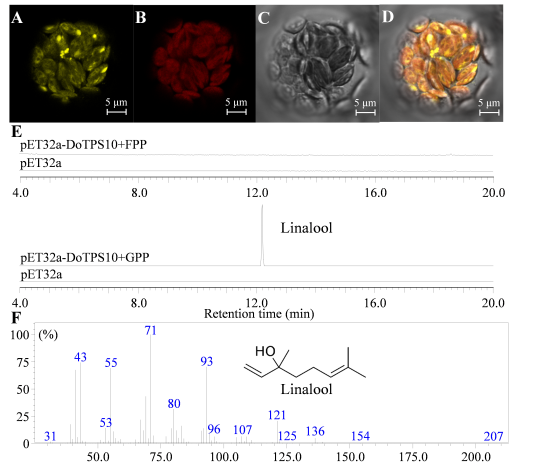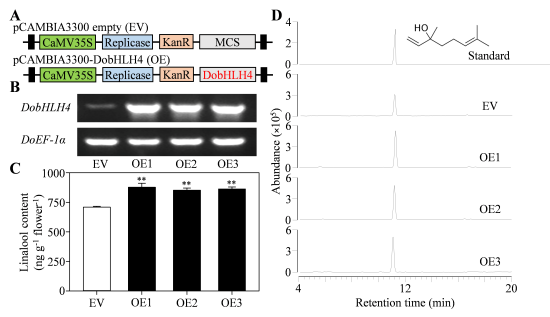

Orchid plants are the most species-rich plants and highly interact with pollinators via visual or olfactory cues. Biosynthesis and emission of floral scent (e.g. linalool, geraniol) to the atmosphere facilitate the olfactory cues and ensure successful pollination. Economically important ornamental flowers, including the orchids Dendrobium officinale, have a particularly high content of monoterpenes, comprising linalool, geraniol and their derivatives. However, information on transcriptional regulation of terpene biosynthesis remains limited, and few studies have been focused on monocots, especially on monocot aromatic flowers.
With the introduction of Prof. DUAN Jun, Dr. YU Zhenming from the South China Botanical Garden, Chinese Academy of Sciences, investigate the MeJA-responsive DobHLH4 promotes DoTPS10, which is involved in linalool biosynthesis. The chloroplast-localized DoTPS10 functioned as a linalool synthase based on evidence that recombinant DoTPS10 specifically catalyzed the heterologous production of linalool from GPP (Figure 1). DobHLH4 during floral development was positively correlated with DoTPS10 (R2 = 0.985, p < 0.01). The nuclear-targeted DobHLH4, a transcription activator, activates and directly binds to the DoTPS10 promoter. Transient overexpression of DobHLH4 in D. officinale petals increased significantly linalool accumulation (Figure 2), and concomitantly upregulated the expression of linalool biosynthetic genes, suggesting that DobHLH4 functions as a positive regulator of the formation of linalool by modulating DoTPS10 expression.
Furthermore, MeJA-inducible DobHLH4 physically interacted with DoJAZ1. A hypothetical model is illustrated that JA-activated DobHLH4 functions in the accumulation of linalool. In the absence of JA or low JA, DobHLH4 interacts with DoJAZ1 without targeting DoTPS10, which attenuates the transcriptional activation activity of DobHLH4 at the DoTPS10 promoter, thereby decreasing linalool accumulation. In the presence of JA, DobHLH4 is recognized by SCFCOI1 (the JA receptor) and subsequently degraded by the 26S proteasome. DobHLH4 is then released and activates the DoTPS10 promoter, thereby enhancing the accumulation of linalool.
The present study illustrates that DobHLH4 acts as a positive regulator in linalool biosynthesis, and provide a feasible strategy for promoting linalool accumulation by JA-mediated transcriptional regulation in orchid plants.
For further reading, please refer to: https://doi.org/10.1016/j.plantsci.2021.110952.

Figure 1. Functional characterization of DoTPS10

Figure 2. Transient over-expressing DobHLH4 in D. officinale petals that promotes linalool accumulation

